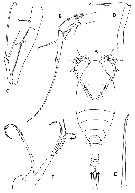|
|
 |
|
Siphonostomatoida ( Order ) |
|
|
| |
| | | |
| Megapontiidae Heptner, 1968 ( Siphonostomatoida ) | | Ref.: | Heptner, 1968 a (p.1637); Kabata, 1979 (p.52); Razouls, 1982 (p.722); Bowman & Abele, 1982 (p.12); Huys & Boxshall, 1991 (p.243, 250, 422, 464 ); Razouls, 1993 (p.313); Boxshall & Halsey, 2004 (p.16; 785: Def.); Vives & Shmeleva, 2010 (p.400, Rem., spp. key.) | | Rem.: | Commensal forms, accidentally in the plankton. 1 G.: Hyalopontius Sars, 1909.
Diagnosis from Boxshall & Halsey (2004, p.785):
- Body slender, cyclopiform.
- Prosome comprising cephalothorax incorporating 1st pedigerous somite, and 3 free pedigerous somites.
- Urosome 5-segmented in female, with genital and 1st abdominal somites fused to form genital double-somite; 6-segmented in male.
- Genital apertures lateral in female, ventral in male.
- Caudal rami with 6 setae.
- Rostrum well developed, ventrally directed.
- A1 11-segmented with aesthetasc on elongate segment 11 in both sexes, non geniculate in male. Segmented homologies (based on Hyalopontius boxshalli): segment 1 (I-IV) compound, segments 2 (V) to 5 (VIII) free, segment 6 (IX-XIII) compound, segments 7 (XIV) to 10 (XVII) free, apical segments (XVIII-XXVIII) compound. Setal formula: 6, 1, 2, 1, 1, 6+1, 3+1, 2, 2, 2, 13 + aesthetasc; spine on segment 6 usually acute, that on segment 7 with rounded tip.
- A2 with coxa and basis unarmed, basis sometimes forming allobasis by fusion with 1st endopodal segment; endopod segment 1 free or fused to basis, segment 2 representing a double segment, armed with 3 setae; exopod 1-segmented with 3 setae.
- Oral cone short, well developed, with oral disc formed by labium.
- Md an elongate stylet, dentate at tip; palp absent.
- Mx1 bilobed: large inner lobe (endite) bearing 3 apical setae; outer lobe (palp) with 2 setae.
- Mx2 slender, with unarmed claw.
- Mxp with indistinctly separated syncoxa and basis, and a single endopodal segment representing 3 fused segments; setal formula 1, 1, 2 + claw.
- Swimming legs 1 to 4 biramous with 3-segmented rami. Intercoxal sclerites present. Inner seta on basis of P1 absent. Spine and setal formula typically as in following Tableau. |  Issued from : G.A. Boxshall & S.H. Halsey in An Introduction to Copepod Diversity, Part II, The Ray Society, 2004, Part II, No 166. [p.785]. Spine (Roman numerals) and setae (Arabic numerals) formula of swimmings legs P1 to P4. Element (s) on the outer margin of any segment are given first, separatd by a hyphen from the inner margin element (s) Nota: Swimming legs P1 to P4 biramous with 3-segmented rami. Intercoxal sclerites present. Inner seta on basis of P1 absent. - P5 with protopodal segment fused ton somite; exopod 1-segmented with 3 setae; endopod absent. P6 represented by a single seta on genital operculum in female and by a lobe bearing 1 seta and 2 spines in male. |
 Issued from : G.A. Boxshall & S.H. Halsey in An Introduction to Copepod Diversity, Part II, The Ray Society, 2004, Part II, No 166. [p.786, Fig.266]. A, Hyalopontius enormis female; B, Hyalopontius typicus female A2; C, Mxp; D, Hyalopontius spinatus female Mx2; Md; F, Hyalopontius roei female Mx1. from Boxshall, 1979. | | | | | (1) Hyalopontius Sars, 1909 | |
| | Syn.: | Megapontius Hulsemann, 1965 (p.50) | | Ref.: | Sars, 1909 (p.6); Boxshall, 1979 (p.243, spp. Key); Razouls, 1982 (p.722); Boxshall, 1986 (p.160, 202); Huys & Boxshall,1991 (p.246, 326, 414); Vives & Shmeleva, 2010 (p.400, Rem., spp. key from Iberica Fauna.) | | Rem.: | Type: Hyalopontius typicus G.O. Sars,1909. Total: 9 spp.
Boxshall & Halsey (2004, p.785) point to that species are deep-sea plankton (at depths ranging from about 2500 to over 4000 m in the northeastern Atlantic). The hosts are unknown. | | Remarks on dimensions and sex ratio: | | The mean female size is 5.170 mm (n = 9; SD = 1.0437) and the mean male size is 4,815 mm (n= 4; SD = 0.1895). The size ratio (Male: Female) for only one species is 0,949 or 94,9 %. | | |
|
|
 Any use of this site for a publication will be mentioned with the following reference : Any use of this site for a publication will be mentioned with the following reference :
Razouls C., Desreumaux N., Kouwenberg J. and de Bovée F., 2005-2026. - Biodiversity of Marine Planktonic Copepods (morphology, geographical distribution and biological data). Sorbonne University, CNRS. Available at http://copepodes.obs-banyuls.fr/en [Accessed January 19, 2026] © copyright 2005-2026 Sorbonne University, CNRS
|
|
 |
 |




